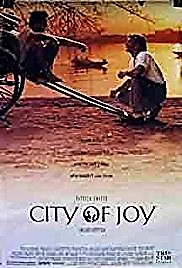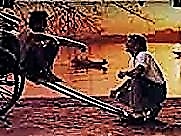City of Joy ** (1992, Patrick Swayze, Pauline Collins, Om Puri, Art Malik) – Classic Movie Review 6620
Director Roland Joffé’s earnest 1992 drama City of Joy is based on the book by Dominique Lapierre. It stars Patrick Swayze as Max Lowe, an American doctor who comes into Calcutta to solve his mid-life crisis.
He is befriended by an Englishwoman called Joan Bethel (Pauline Collins), who is running a medical centre, helped by Hazari Pal (Om Puri), the head of a struggling Indian family, who is running a rickshaw courtesy of the local godfather Ghatak (Shyamanand Jalan) and his evil son, Ashok Ghatak (Art Malik).
Soon all the good guys are helping each other and taking on the bad guys in this simplistic, heart-warming movie. Why didn’t screen-writer Mark Medoff paint any shades of grey in this strictly black and white painted film? [It is shot in colour, of course.]
Without subtlety and ambiguity, all that is left is the well-meaning touching uplift and the decent acting from the well-scrubbed Swayze (who is fine, though you expect him to burst into song and dance at any moment), the spunky Collins (who is delightful, though more of her would be better), and the excellent Puri (who gives the film’s best performance).
City of Joy’s other very considerable assets are the atmospheric pictures of India’s slums shot by Peter Biziou, the lush score by Ennio Morricone, and the hopeful if commonplace message about sticking together and life will be alright. This should bring joy enough, but there is a whole dimension missing as the realities of illness, poverty and wickedness are put on hold. Against the realities of the Third World, Swayze’s crisis of conscience doesn’t really seem to amount to a hill of beans.
Also in the cast are Shabana Azmi, Ayesha Dharker and Santu Chowdhury.
City of Joy is produced for Allied Filmmakers, Lightmotive and Pricel by Jake Eberts and Roland Joffé, and designed by Roy Walker.
It was fairly costly at $27,000,000, and earned back only $14,683,921 in the US.
© Derek Winnert 2018 Classic Movie Review 6620
Check out more reviews on http://derekwinnert.com



